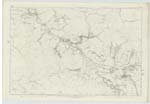OS1/3/21/51
| List of names as written | Various modes of spelling | Authorities for spelling | Situation | Description remarks |
|---|---|---|---|---|
| PICKAN'S DYKE | Pickan's Dyke Pickan's Dyke Pickan's Dyke Pickan's Dyke Pickan's Dyke |
- A. Hervey W. Gilchrist W. G. Galloway Patersons History of Ayrshire |
046 | A dilapidated turf Bank about two feet high ten feet wide at the base, with a ditch on the South Side of nearly the Same breadth, the ditch or fosse is nothing more than when the turf was dug out to build the fence and is now nearly level with the adjoining land. The portion of it that can be traced extends from the new Grave Yard at the north east end of the village of Dalmellington to the top of Mains Hill a distance of about half a mile, all further trace of it is lost either South east or South west as its direction indicates. This can be none of that Dyke Called by Some 'Roman Dyke' by others 'Picts Dyke' but most commonly 'Deil's Dyke' which traversed the Country from Lochryan, through the north of Wigton, Kirkcudbright, and Dumfries Shires till it joined the 'Britton Wall' near the Solway Firth for it had the fosse on the north and this has it on the South also that Dyke took nearly a straight direction from the Merrick to the Old Bridge of Deuch near Carspherin from both those circumstances it is plainly seen that it was none of the Deil's Dyke. There may have been other Dykes built by the Picts but neither History nor tradition makes the least mention of the one in question. I have Seen hundreds of the like old fences on the moors even at the place where this is there are Several old banks that are as likely to be Pict's Dykes as the one pointed out; the people here generally speaking Say that it was no more than a fence enclosing Some patches of arable like all the other old banks on hill tops or Sides its well known thant in olden times the hilltops and Sides were more cultivated that the lowlands and consequently to this day you will meet with an innumerable quantity of old banks on the Hills. It has none of the appearances of being built of Stone or any other material but Turf all the other old banks are as wide and some more so that it. - |
Continued entries/extra info
[Page] 51Parish of Dalmellington -- Sheet 46 - 12 & 16
"On the muir called the Common of Dalmellington an interesting remain exists,
"popularly called Pickan's (i.e. the Pict's) Dyke. About five hundred yards of it
" can be distinctly traced from the village on the eastward to the ridge of the hill.
"It appears to have consisted of a wall & ditch; the breadth of both averaging from
"21 to 24 feet. The wall, composed probably of a mixture of stone and earth, is
"still, in some places, two or three feet high, and the ditch correspondingly low.
"This barrier seems to have taken a south-westerly direction from Dalmellington, entering
"Galloway by the bend of Alcreoch hill, on the opposite side of the Doon. Eastward
"it run into Dumfriesshire, terminating, it has been surmised, in the Solway.
"It is rather curious that that this very distinct relic of antiquity should not have
"been noticed by any of our topographical writers. The dyke mentioned in the
" 'History of Galloway' as rising from Lochryan, by Minnigaff & Lochmaben to
"the Solway, could have no connection with it. The ditch or fosse of the Lochryan
"wall is described as on the north side, forming a protection to those on the south; that at
"Dalmellington is on the south, showing that the enemy to be resisted lay in that
"direction. It would be useless to speculate as to the period or people to whom such remains
" are attributable - whether the Darnŭii against the Romans; the Alcluydensians against the
"Saxons or Cruithrie; but from the cairns that have been found in the vicinity, there can be little
"doubt that the Pickan's Dyke was erected for a warlike purpose, and that, too, long before the
"era of authentic history" Pattersons History of Ayrshire (1847)
Transcribers who have contributed to this page.
Chr1smac -Moderator, hillhere
Location information for this page.
Linked mapsheets.




